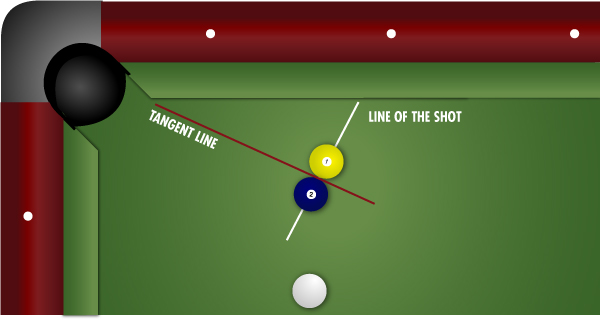Mastering Cue Ball Control: The Tangent Line and Speed Effects in Billiards
In the world of billiards, few skills are more important than cue ball control. Being able to predict and guide where the cue ball will travel after striking the object ball can make the difference between a winning run and a missed opportunity. One of the key concepts that every player, from beginner to advanced, must understand is the tangent line—the natural path the cue ball follows after contact.
But the tangent line is only part of the story. The speed of the shot—slow, medium, or fast—changes the cue ball’s behavior dramatically. In this article, we will break down the tangent line, how speed affects cue ball movement, and how you can use this knowledge to improve your game.

What Is the Tangent Line?
The tangent line is the natural 90-degree angle the cue ball takes immediately after hitting the object ball with no spin applied. Imagine drawing a line at a right angle to the object ball’s path—that’s the tangent line.
For example:
-
If you hit the cue ball straight into the object ball, the object ball will follow its intended path toward the pocket.
-
Meanwhile, the cue ball will deflect off along the tangent line, typically at a 90-degree angle relative to the object ball’s direction.
This predictable angle is a powerful tool. Once you master it, you can plan position play more effectively, leaving yourself set up for the next shot instead of relying on luck.

How Speed Changes the Cue Ball’s Path
While the tangent line gives a basic guideline, cue ball speed can alter the final direction after contact. The diagram above illustrates this concept:
-
Slow Speed: At lower speeds, friction between the cue ball and the cloth causes the ball to grab the table surface more quickly. As a result, the cue ball curves forward after contact, deviating inside the tangent line.
-
Medium Speed: At moderate speeds, the cue ball stays closer to the tangent line. This is often considered the “true tangent line” zone, where the ball follows the most predictable path.
-
Fast Speed: At high speeds, the cue ball slides longer before friction takes effect. It tends to deflect outside the tangent line, continuing further along its original sliding path.
Understanding how speed changes the angle is essential for precise cue ball placement.
Applying Tangent Line Knowledge in Real Games
Knowing the tangent line and speed effects can transform your playing strategy:
-
Position Play
Instead of just pocketing the ball, you can plan exactly where the cue ball will stop. For example, hitting with slow speed can help bring the cue ball closer to your next shot, while fast speed may help it travel further down the table. -
Safety Shots
If you need to play a defensive shot, you can use tangent line knowledge to guide the cue ball behind blocking balls, making it harder for your opponent to respond. -
Breaking Clusters
Sometimes, balls are grouped together. Striking the cue ball with speed along the tangent line can break clusters apart, giving you better chances for future shots.
Common Mistakes Beginners Make
Many beginners struggle with cue ball control because they misunderstand the tangent line. Here are common errors:
-
Ignoring Speed Effects: Assuming the cue ball will always follow the same 90-degree angle. In reality, speed can shift the path significantly.
-
Overhitting: Using too much power when a soft stroke would provide better control.
-
Not Practicing with Purpose: Playing casually without focusing on cue ball placement makes it hard to improve.
Correcting these mistakes involves mindful practice and observation.

Drills to Practice Tangent Line and Speed Control
To build confidence, try these drills:
-
Tangent Line Drill
-
Place the cue ball and object ball in a straight line to a pocket.
-
Shoot the object ball in while observing where the cue ball goes.
-
Adjust your speed and note how the path changes.
-
-
Speed Control Drill
-
Place three markers (like coins) on the table along different angles.
-
Try hitting the object ball so the cue ball lands near each marker using slow, medium, and fast speeds.
-
-
Position Play Drill
-
Set up a three-ball layout.
-
After pocketing the first ball, use tangent line and speed knowledge to position the cue ball for the second shot, then continue for the third.
-
These drills will train your muscle memory and improve your ability to predict outcomes during real matches.

The Mental Side of Cue Ball Control
Cue ball control is as much mental as it is physical. Great players visualize the path before they strike. They imagine not just pocketing the ball but also the exact journey of the cue ball afterward.
A good pre-shot routine includes:
-
Visualizing the tangent line.
-
Deciding whether to use slow, medium, or fast speed.
-
Committing to the stroke with confidence.
The more you practice this mental discipline, the more automatic your cue ball control will become.
Conclusion
The tangent line is one of the most powerful concepts in billiards. By understanding how the cue ball naturally travels after hitting the object ball—and how speed changes that path—you can take your game to the next level.
Instead of leaving your cue ball position to chance, you’ll have the skills to control it with precision. Whether you’re planning a smooth run-out, playing a safety, or breaking up clusters, cue ball control is the difference between casual play and competitive success.
